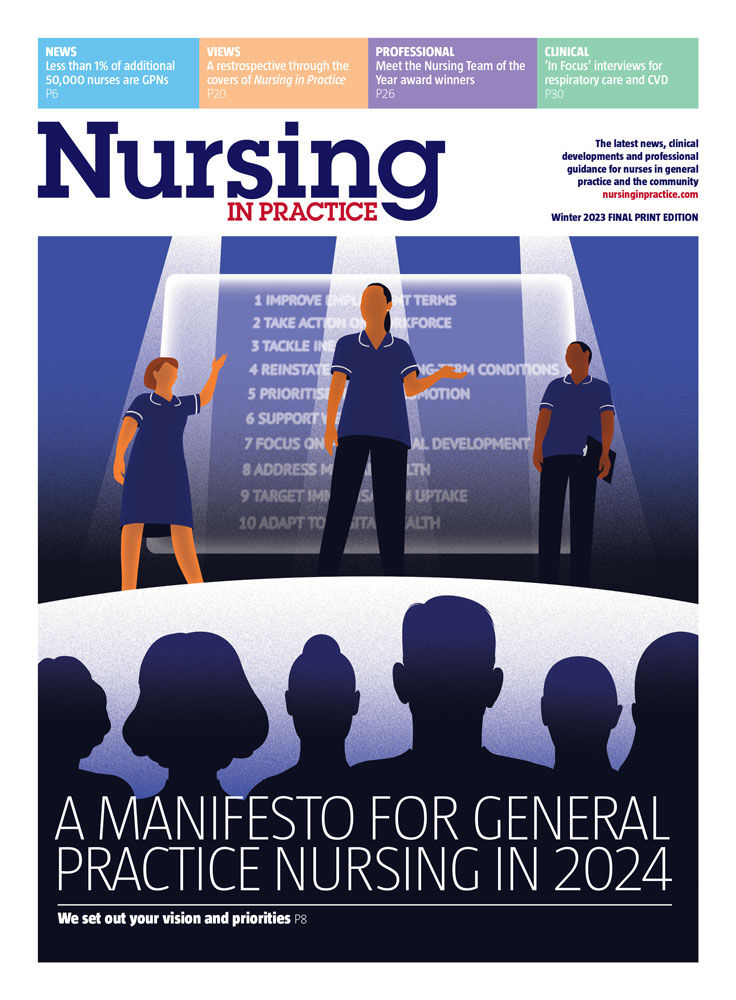Key learning points
- Bronchiolitis is the most common lower respiratory tract infection in infants up to one year of age
- Viral respiratory tract infections do not require antibiotic treatment
- Children with bronchiolitis should be referred immediately if they have a respiratory rate over 70, apnoea, or look seriously unwell
Upper respiratory tract infection should be considered in a child with a cough and signs of infection, and a clear chest on examination. But no combination of symptoms or signs has been shown to give absolute clinical certainty in diagnosing any of the conditions below in young children, and often it is a combination of subjective and objective findings that will indicate the need for treatment or admission.
Viral respiratory tract infections are self-limiting and do not require antibiotic treatment. It is central to care that the assessment and advice given to parents is thorough and complete. On average, fever settles three to seven days following onset. If a child’s symptoms are associated with a cough this will resolve within three weeks in most cases.1
|
Table 1 Which symptoms require referral? |
|
|---|---|
|
Clinical feature |
Red flag for referral  |
|
Respiratory distress with tachypnoea |
Yes |
|
Cough with a wheeze on auscultation of the chest |
Yes |
|
Cyanosis or use of accessory muscles resulting in chest wall recession |
Yes |
|
Saturations <92% |
Yes |
|
Preceding coryzal symptoms with fever <38°C |
Consider |
|
Poor feeding because of snuffly nose, nasal discharge or sneezing |
Consider |
Viral-induced wheeze
This largely affects children between six months and five years. It is associated with respiratory tract infection and in the majority of children the tendency to wheeze remits by the age of six. The mechanism by which infection causes wheeze is not fully understood, but it is known that these children have abnormally small airways.2
Infective exacerbations of asthma
These may be difficult to distinguish from viral-induced wheeze in a child younger than five. In an infective exacerbation of asthma, wheezing occurs because of bronchoconstriction in response to a respiratory tract infection (most commonly viral), but may also have been observed in response to typical asthma triggers, such as exercise and exposure to allergens. Asthma is more common in children with atopy or a family history of atopy.3
Bronchiolitis
This predominately affects infants aged up to 12 months. It is caused by a viral infection, most commonly respiratory syncytial virus, of the epithelial lining of the lower bronchial tree.4,5 Infected epithelial cells slough off into the small airways and the alveolar spaces. This, together with mucus, causes variable obstruction of the small airways, with complete obstruction and collapse in some, and partial obstruction in others. These changes result in impaired gas exchange, leading to hypoxia and breathlessness.6
Community-acquired pneumonia
This is an acute infection of the lung parenchyma that may be caused by bacterial or viral infection. Infection leads to localised collapse and consolidation of the alveolar air spaces, resulting in impaired gas exchange, which may cause hypoxia and breathlessness.7,8
Asthma
This is diagnosed following a thorough history and examination. Investigations are not usually indicated as most children with asthma will have normal spirometry between exacerbations.
| Case study |
|---|
|
Ryan, a four-month-old infant, is brought into surgery by his mum with a three-day history of poor feeding and sleeping with intermittent crying, usually at night. He is restless and will not feed properly. She asks you if you think he should have antibiotics, as these have worked well in the past |
Usually, a lower respiratory tract infection of infants is characterised by the signs and symptoms seen in table 1.
In our case, Ryan has bronchiolitis, which is a clinical diagnosis and does not require any investigations. Nasopharyngeal aspirates can be used to identify the causative virus. A chest X-ray is not routinely indicated in young children as it will have no bearing on management unless there is a suspicion of underlying pathology. If a chest X-ray is performed, the findings consistent with bronchiolitis include hyperinflation, patchy atelectasis and perihilar bronchial wall thickening.
What to do in this case: managing bronchiolitis
1. Determine the severity of the child’s condition
- Note the degree of agitation and consciousness. Agitation and behavioural changes in a child may be a sign of hypoxia.
- Look for signs of exhaustion, cyanosis (bluish lips or extremities) and use of accessory muscles while the child is at rest.
- Examine the child’s chest, and record their respiratory rate, pulse, and blood pressure.
- Measure the child’s oxygen saturation in room air using pulse oximetry (if available).
- Assess the child’s hydration status by measuring capillary refill time, examining skin turgor and dryness of mucous membranes, and ascertaining urine output.
2. Immediately refer children with bronchiolitis for emergency hospital care (usually by 999 ambulance) if they exhibit any of the following signs:
- Apnoea (observed or reported).
- Child looks seriously unwell.
- Severe respiratory distress, for example grunting, marked chest recession, or a respiratory rate of over 70 breaths per minute.
- Central cyanosis.
- Persistent oxygen saturation of less than 92% on air.
Note: Impending respiratory failure may be indicated by listlessness or decreased respiratory effort, recurrent apnoea or failure to maintain adequate oxygen saturation despite oxygen supplementation.
3. If the child has none of the above, consider referral for any of the following:
- Respiratory rate over 60 breaths per minute.
- Difficulty with breastfeeding or inadequate oral fluid intake (50-75% of usual volume).
- Clinical dehydration (indicated by reduced skin turgor or a capillary refill time of more than three seconds, or dry mucous membranes, or reduced urine output).
- Factors that lower the threshold for hospital admission include:
- Chronic lung disease (including bronchopulmonary dysplasia).
- Haemodynamically significant congenital heart disease.
- Neuromuscular disorders.
- Immunodeficiency.
- Age under three months.
- If the infant was born prematurely, particularly before 32 weeks.
- Factors that might affect a carer’s ability to look after a child with bronchiolitis, such as adverse social circumstances, concerns about the skill and confidence of the carer, or the carer being able to spot red-flag symptoms.
- Longer distance to healthcare in case of deterioration.
- While awaiting admission to hospital:
- Give controlled supplementary oxygen to all children whose oxygen saturation is persistently less than 92%.
4. If the child does not require admission:
- Advise the parents or carers that bronchiolitis is usually a self-limiting illness and that symptoms tend to peak between three and five days of onset.
- Provide self-care advice:
– Advise the parents or carers to use either paracetamol or ibuprofen to treat a child who is distressed because of fever. Antipyretic agents should not be used with the sole aim of reducing body temperature and should be continued for only as long as the child appears distressed.
– Advise the parents or carers to consider changing to the other agent if the child’s distress is not alleviated, but not to give both agents simultaneously, and to only alternate these agents if the distress persists, or recurs before the next dose is due.
– Advise them not to attempt to reduce fever by under-dressing the child or with use of tepid sponging. Advise them to encourage the child to take fluids regularly. For infants that are breastfed, advise continued breastfeeding.
- For children managed at home, parents should check on the child regularly, including through the night, and seek medical advice if they are unable to cope, or if the child deteriorates, particularly if:
– Breathing rate increases or there are any episodes of apnoea, signs of cyanosis, or increased effort of breathing (such as grunting, nasal flaring or marked chest recession).
– Fluid intake is reduced to 50-75% of normal, or there are signs of dehydration such as dry mouth or no wet nappy for 12 hours.
– The child becomes less responsive or difficult to rouse. There is persistent worsening of fever.
- Advise the parents or carers not to smoke in the home as this increases the risk of more severe symptoms.
- Use clinical judgment to determine whether follow-up is necessary.
References
1 Shields M, Bush A, Everard M. Recommendations For The Assessment And Management Of Cough In Children. Thorax 2008;63:iii1-iii15
2 Wilson N. Virus Infections, Wheeze And Asthma. Paediatric Respiratory Reviews 2003;4:184-92
3 British Thoracic Society (BTS) and Scottish Intercollegiate Guidelines Network (SIGN). British Guideline On The Management Of Asthma. 2016
4 SIGN. Bronchiolitis In Children: A National Clinical Guideline. 2006
5 NICE. Bronchiolitis in Children 2016 nice.org.uk/guidance/qs122
6 DeVincenzo J. A New Direction In Understanding The Pathogenesis Of Respiratory Syncytial Virus Bronchiolitis: How Real Infants Suffer. Journal of Infectious Diseases 2007;195:1084-6
7 Bartlett J. Pneumonia in the normal host. In: Oxford Textbook of Medicine. Warrell D, Cox T, Firth J (eds). Oxford University Press 2010
8 Harris M, Clark J, Coote N et al. British Thoracic Society Guidelines For The Management Of Community Acquired Pneumonia In Children. Thorax 2011;66(Suppl 2), ii1-ii23
9 Martinez F, Wright A, Taussig L et al. Asthma And Wheezing In The First Six Years Of Life. The Group Health Medical Associates. New England Journal of Medicine 1995;332:133-8
10 Asthma UK Asthma Facts And Statistics 2016
11 NICE. Bronchiolitis In Children: Diagnosis And Management 2015 nice.org.uk/guidance/ng9
12 Public Health England. Management Of Infection Guidance For Primary Care For Consultation And Local Adaptation. 2015 gov.uk/government/uploads/system/uploads/attachment_data/file/507191/Managing_Common_Infections.pdf
13 Clark J, Hammal D, Hampton F et al. Epidemiology of community-acquired pneumonia in children seen in hospital. Epidemiology and Infection 2007;135:262-9








